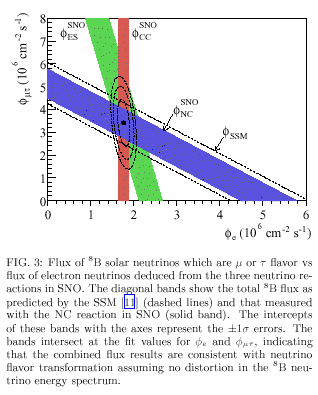 ...".
...".one for each of the 3 generations of fermions. According to a Particle Data Group Particle Properties review (revised August 2001) by D. Karlen:
"... The most precise measurements of the number of light neutrino types, Nv, come from studies of Z production in e+e- collisions. The invisible partial width ... is determined by subtracting the measured visible partial widths, corresponding to Z decays into quarks and charged leptons, from the total Z width. The invisible width is assumed to be due to Nv light neutrino species each contributing the neutrino partial width ... as given by the Standard Model. ... The combined result from the four LEP experiments is Nv = 2.984 +/- 0.008 ...".
According to hep-ph/0302191 (20 Feb 2003) by Bhattacharyya, Pas, Song, and Weiler "... the WMAP data ... places significant limits on the contribution of neutrinos to the energy density of the universe ... which translates into ...[the sum of all the nu masses being less than] ... 0.71 eV (95%C.L.). ...".
For a good introduction to the basic ideas of Neutrino Physics, see the book From Dirac to Neutrino Oscillations, by Tino Ahrens (Kluwer 2000).
However, no book can tell us what is not known, and as of now, a lot is unknown about Neutrino Physics, and therefore it is useful to ask, about Neutrino Oscillations:
According to Gary Feldman ( slide 10 of lecture slides for the August 2000 SLAC Summer Institute ): "...
The solar neutrino problem has been closed and the ability of neutrinos to change from one type, or "flavor," to another established directly for the first time by the efforts of the Sudbury Neutrino Observatory (SNO) collaboration. ...Measurements dating back to the 1960's of this neutrino flux were puzzling: only a fraction of the expected number arrived at detectors on Earth. Suspicion naturally fell on the experiments and on the standard solar model (SSM) used to calculate the flux. Soon, however, the neutrinos themselves were implicated. If on their journey to Earth some of the neutrinos (basically solar reactions produce electron-neutrinos exclusively) had changed into muon- or tau-neutrinos, then terrestrial detectors designed only to spot electron neutrinos (e-nu's) would be cheated of their rightful numbers.
SNO scrutinizes a particular reaction in the sun: the decay of boron-8 into beryllium-8 plus a positron and an e-nu. SNO's gigantic apparatus consists of 1000 tons of heavy water (worth $300 million Canadian) held in an acrylic vessel surrounded by a galaxy of phototubes, the whole residing 2 km beneath the Earth's surface in an Ontario mine, the better to filter out distracting background interactions.
Last year SNO reported first results based on reactions in which a solar neutrino enters the detector and either (1) glances off an electron in one of the water molecules (this so-called elastic scattering (ES) is only poorly sensitive to muon and tau neutrinos) or (2) combines with the deuteron to create an electron and two protons, a reaction referred to as a "charged current" (CC) interaction since it is propagated by the charged W boson. The SNO data, when supplemented with ES data from the Super Kamiokande experiment in Japan, provided preliminary evidence a year ago for the neutrino-oscillation solution for the solar neutrino problem. ...
The new findings update last year's CC and ES data and introduce, for the first time, evidence deriving from a reaction in which the incoming neutrino retains its identity but the deuteron (D) is sundered into a proton and neutron; this is why SNO went to such trouble and expense of using D2O-for the weakly bound neutron inside each D. This interaction, called a neutral-current (NC) reaction because the operative nuclear voltage spreads in the form of a neutral Z boson, is fully egalitarian when it comes to neutrino scattering; unlike last year's ES data, the NC reaction allows e-nu's, mu-nu's, and tau-nu's to scatter on an equal footing.
The upshot: all the nu's from the sun are directly accounted for. The missing nu-e flux shows up as an observable mu-nu and tau-nu flux. This conclusion is established with a statistical surety of 5.3 standard deviations, compared to the less robust 3.3 of a year ago. The measured e-nu flux (in units of one million per cm2 per second) is 1.7 while that for the mu-nu and tau-nu combined is 3.4. (When one includes all the other types of neutrinos, the flux from the sun is billions/cm^2/sec.)
Even the issue of how the neutrino changes from one flavor to another can be addressed by viewing the day-night asymmetry of neutrino flux. When the whole of the earth is between the sun and the detector (night viewing) the oscillation process, which depends on a density of matter through which the nu proceeds, should be speeded up. This type of measurement will also contribute to the eventual study of neutrino mass. An experiment like SNO can measure not mass but the square of the mass difference between nu species. ...".
"... Solar neutrinos from the decay of 8B have been detected at the Sudbury Neutrino Observatory (SNO) via the charged current (CC) reaction on deuterium and by the elastic scattering (ES) of electrons. The CC reaction is sensitive exclusively to nu_e's, while the ES reaction also has a small sensitivity to nu_mu's and nu_tau's. The flux of nu_e's from 8B decay measured by the CC reaction rate is ...[
]... Assuming no flavor transformation, the flux inferred from the ES reaction rate is ...[ about 2.39 x 10^6 cm^(-2) s^(-1) ]... SNO's ES rate measurement is consistent with the precision measurement by the Super-Kamiokande Collaboration of the 8B flux using the same ES reaction ...[ about 2.32 x 10^6 cm^(-2) s^(-1) ]... Comparison of ...[ the SNO CC nu_e flux ]... to the Super-Kamiokande Collaboration's precision value of ...[ the ES nu_e flux ]...yields a 3.3 sigma˙difference, providing evidence that there is a non-electron flavor active neutrino component in the solar flux. The total flux of active 8B neutrinos is thus determined to be ...[ about 5.44 x 10^6 cm^(-2) s^(-1) ]... in close agreement with the predictions of solar models. ...".
"... The Sudbury Neutrino Observatory (SNO) has measured day and night solar neutrino energy spectra and rates. For charged current events, assuming an undistorted 8B spectrum, the night minus day rate is 14.0% +/- 6.3% +1.5 - 1.4% of the average rate. If the total flux of active neutrinos is additionally constrained to have no asymmetry, the nu_e asymmetry is found to be 7.0% +/- 4.9% +1.3 - 1.2%.A global solar neutrino analysis in terms of matter-enhanced oscillations of two active flavors strongly favors the Large Mixing Angle (LMA) solution. ...".
"... Observations of neutral-current neutrino interactions on deuterium in the Sudbury Neutrino Observatory are reported. Using the neutral current, elastic scattering, and charged current reactions and assuming the standard 8B shape, the nu_e component of the 8B solar flux is
for a kinetic energy threshold of 5 MeV. The non-nu_e component is
5.3 sigma greater than zero, providing strong evidence for solar nu_e flavor transformation. The total flux measured with the NC reaction is
consistent with solar models. ...
 ...".
...".
According to the 2000 Particle Data Book: "... Now, as we have seen, the dM^2 values required to explain the atmospheric, solar, and LSND oscillations are of three different orders of magnitude. ... Hence, to explain all three of the reported neutrino oscillations, one must introduce a fourth neutrino. Since this neutrino is known to make no contribution to the width of the Z0, it must be a neutrino which does not participate in the normal weak interactions - a "sterile" neutrino. ...".
According to Gary Feldman, the Solar favored solution disfavors the existence of a sterile neutrino at 95% CL However, Barger, Mafatia, and Whisenant in hep-ex/0106207 say: "...We perform a model-independent analysis of solar neutrino flux rates including the recent charged-current measurement at the Sudbury Neutrino Observatory (SNO). We derive a universal sum rule involving SNO and SuperKamiokande rates, and show that the [ forthcoming ] SNO neutral-current measurement can only fix the fraction of solar nu_e oscillating to sterile neutrinos if the 8B neutrino flux normalization is assumed to be known. Imposing adiabatic constraints do give an unique solution for the sterileneutrino fraction, but the uncertainties are large. ... We discuss the additional measurements that are needed to determine, in a model-independent way, the oscillation probabilities and the fraction of solar nu_e that may be oscillating to sterile neutrinos. What is needed is a measurement of neutrino-nucleon NC scattering for the intermediate-energy neutrinos, which, like the SNO NC measurement of high-energy neutrinos, has equal strength for all active neutrinos. In order to experimentally determine the flux of intermediate energy neutrinos, a low energy neutrino flux measurement involving a neutral currents is needed. ...".
In hep-ph/0108191, M.V. Garzelli and C. Giunti take a
They say: "... We show that the Bayesian analysis of solar neutrino data does not suffer any problem from the inclusion of the numerous bins of the CHOOZ and Super-Kamiokande electron energy spectra and allows to reach the same conclusions on the favored type of neutrino transitions and on the determination of the most favored values of the oscillation parameters in both the Rates and Global Analysis.
... We present also the results of a standard least-squares analysis of solar neutrino data and we show that the standard goodness of fit test is not able to rejects pure nu_e -> nu_s transitions. ...".
Using the Standard Solar Model, in which temperature, density, and pressure decrease monotonically from the center of the Sun to its photosphere/surface, John N. Bahcall, in his book Neutrino Astrophysics (Cambridge 1989), says with respect to his figure 8.1
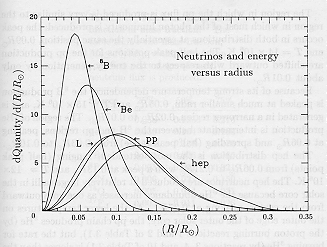
"... The region in which the pp flux is produced is very similar to the region in which most of the photon luminosity is produced ... 0.09 Rs [where Rs is the solar radius] ...the 8B production is peaked at much smaller radii, 0.05 Rs ...".
A recent detailed description of solar models is given in astro-ph/0010346, by Bahcall, Pinsonneault, and Basu.
In his paper An Introduction to Solar Neutrino Research (hep-ph/9711358), Bahcall says: "... Figure 1 ...compares the measured and the calculated event rates in the four pioneering experiments, revealing three discrepancies between the experimental results and the expectations based upon the combined standard model. ...
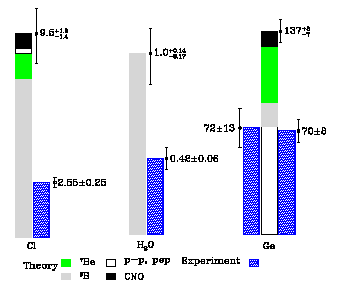
... The first solar neutrino experiment to be performed was the chlorine radiochemical experiment, which detects electron neutrinos that are more energetic than 0:81 MeV. After more than 25 years of the operation of this experiment, the measured event rate is a factor 3.6 less than is predicted by the most detailed theoretical calculations ... A SNU is 10^(-36) interactions per target atom per second. ...
... The second solar neutrino problem results from a comparison of the measured event rates in the chlorine experiment and in the Japanese water Cerenkov experiment, Kamiokande. ... The water experiment detects higher-energy neutrinos, those with energies above 7 MeV ... According to the standard solar model, 8B beta decay is the only important source of these higher-energy neutrinos. ... we can calculate the rate in the chlorine experiment that is produced by the 8B neutrinos observed in the Kamiokande experiment (above 7 MeV). This partial ( 8B) rate in the chlorine experiment is 3.2 +/- 0.45 SNU, which exceeds the total observed chlorine rate of 2.55 +/- 0.25 SNU. ... The inference that is most often made from this comparison is that the energy spectrum of 8B neutrinos is changed from the standard shape ...
... The results of the gallium experiments, GALLEX and SAGE, constitute the third solar neutrino problem. ... The seeming exclusion of everything but pp neutrinos in the gallium experiments is the "third" solar neutrino problem. ... ".
In hep-ph/0107022, Raychaudhuri and Sil say: "... Table 3: The ratio of the observed solar neutrino rates to the corresponding BBP2000 SSM predictions used in this analysis. ... The Gallium rate is the weighted average of the Gallex, SAGE, and GNO results.
The SNO NC results may be important in determining whether ( as is indicated by SNO CC results ) the Sun follows the Standard Solar Model. John N. Bahcall, in his book Neutrino Astrophysics (Cambridge 1989), says (at pages 240-242, 405-406):
"... Neutral currents distinguish between explanations of the solar neutrino problem that involve revised astrophysics and explanations that involve neutrino oscillations.
- For astrophysical explanations, (i.e., nonstandard solar models) the flux of neutrinos is reduced relative to the standard solar model while the energy spectrum remains the same.
- For explanations involving oscillations, the total flux of neutrinos is the same as in the standard solar model although their flavor distribution is radically different.
Neutral currents are flavor blind. In the standard electroweak theory, neutrinos of different flavors have the same neutral-current interactions. ... The Sudbury solar neutrino collaboration has porposed observing the neutral-current disintegration of deuterium by detecting the gamma rays emitted when the produced neutrons are captured in a doped impurity ...
The cross section for ... the neutral-current reaction ... is independent of the flavor of the incident neutrino. ... the SNO collaboration has had to devise clever methods for ensuring that only a small number of background events can produce neutrons. ... the neutral-current reaction is particularly important for resolving the solar neutrino problem because it gives a flavor-blind measure of the total neutrino flux, providing a test of solar models even if neutrino oscillation occur...".
is a question asked by Carroll and Ostlie in their book An Introduction to Modern Astrophysics (Addison-Wesley 1996).
The SNO papers nucl-ex/016015 and nucl-ex/0204008 report experimental results which, along with those of Super-Kamiokande, are consistent with the existence of neutrino oscillations and with the Standard Solar Model.
However, it is also possible that Non-Standard Solar Models coupled with Non-Standard (or No) Neutrino Oscillations may also be consistent with experimental results.
Therfore, it may be useful to describe some possible Standard Solar Model modifications with respect to Internal Solar Temperatures and Nuclear Reaction Rates.
Carroll and Ostlie say "... if the temperature of the solar interior was approximately 10% lower than theory predicts, the number of solar neutrinos emitted from the core would come into agreement with observation. ...". Their figure 11.4
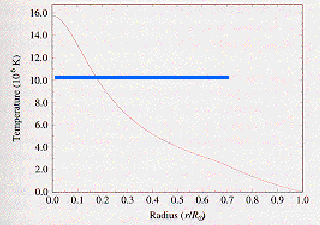
shows how temperature (in units of 10^6 degees K, or about 200 eV) varies from the center of the Sun to its photosphere/surface.
I have added a blue line at about 10 x 10^6 degrees K, or about 2 keV, to suggest the possibility that
in which the interior of the Sun (as well as other celestial bodies) has the structure of "... an ion lattice in a metal. This lattice is deformed by gravity and then the electron gas adapts its density to this deformation. ... the electrons form the degenerated Fermi gas. ... the action of gravity on matter is compensated by the electric force and the gradient of pressure is absent. ... the density of a substance inside a star is constant. ...", may solve the solar neutrino problem.
About helioseismological observations of the Sun, Carroll and Ostlie say: "... pressure provides the restoring force for ... nonradial oscillations ... called p-modes. .... gravity is the source of the restoring force for another class of nonradial oscillations called g-modes ... The oscillations observed in the Sun fall into two general categories:
... p- modes are concentrated below the photosphere within the Sun's convection zone ... g-modes are found ... below the convection zone. ... a definite identification of the g-modes has not been made, and even the existence of the most prominent g-mode is doubted by some astronomers. Its 100-minute period is exactly one-ninth of a solar day, raising the suspicion that it is an obserational artifact produced by the Sun's influence on Earth's atmosphere. ...
... it appears that the convection zone ... occupies roughly the outer 30% [by radius] of the Sun's interior. ... it is strongly suspected that the p-modes are diven by tapping into the turbulent energy of the convection zone itself, where the p-modes are confined. ...".
William J. Kaufmann III, in his book Universe (fourth edition, Freeman 1994) shows in Figure 18-24
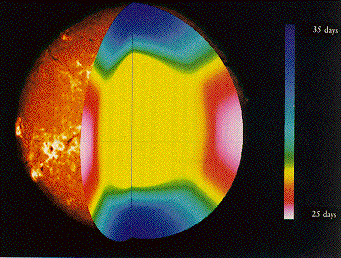
the observed rotation rates of the solar interior, saying: "... the surface rotation pattern, which varies from 23 days at the equator to 35 days near the poles, persists throughout the Sun's convective envelope. The Sun's radiative core seems to rotate like a rigid body. ...".
are discussed by Fukasaku and Fujita, who have shown that "...the solar neutrino data (KAMIOKANDE experiment) can be well described by the [Standard Solar Model] with careful employment of nuclear data ... The main point is that the sinple-minded product ansatz of Coulomb plus nuclear parts should have a few percent uncertainties which induce the large reduction of the neutrino flux from 8B. Also, if the electron capture of 7Be inside the sun is suppressed, then the GALLEX experiment can be understood by the SSM calculation."
Fukasaku and Fujita note that Dar and Shaviv have made "... new calculation ... which shows very similar results ..."
In the D4-D5-E6-E7-E8 VoDou Physics model, all 3 flavors of neutrino are massless at tree level. ( The tree-level massless character of the neutrino means that its Compton Radius Vortex is probably effectively as large as our universe. ) Therefore, at tree level, the D4-D5-E6-E7-E8 VoDou Physics model has no neutrino mixing due to the Kobayashi-Maskawa mass-related matrix, and so has no tree-level neutrino mixing by the MSW mechanism.
However, the tree-level massless neutrinos of the D4-D5-E6-E7-E8 VoDou Physics model could be mixed by Violation of the gravitational Equivalence Principle, in two ways:
Mureika, in hep-ph/9612391, says, about 3-flavor neutrino oscillations induced by VEP: "... Neutrino oscillations induced by a flavor-dependent violation of the Einstein Equivalence Principle (VEP) have been recently considered as a suitable explanation of the solar electron-neutrino deficiency. ...
At heart, the MSW and VEP mechanisms are the same. Both rely on the existence of two distinct eigenstates of the neutrinos. In the former [ MSW ] case, there are mass and electroweak eigenstates ... For the latter [ VEP ] , the mass eigenstate is replaced with a gravitational one ... as the VEP neutrinos are considered massless ...
.... The MSW mechanism is ...[ more often ]... seriously considered ... due to the basic underlying hypothesis of VEP, which requires a generation-dependent violation of the Einstein Equivalence Principle (i.e. flavor-dependent coupling to the background gravitational potential ) in the neutrino sector, and tends to give most physicists a headache. ...
We investigate the differences which arise by considering three-flavor VEP neutrinos oscillating against fixed background potentials, and against the radially-dependent solar potential. This can help determine the sensitivity of the gravitationally-induced oscillations to both constancy and size (order of magnitude) of Phi. ...
... While most papers on VEP tend to agree on the form of the oscillation mechanism, there is some debate as to which background potential is at work. Most works have assumed that neutrinos feel the potential difference of the sun from their creation points, to their exit on the surface, which ranges between [about] (-7,-2) x 10^(-6). Alternatively, ...[Halprin, Leung, and Pantaleone suggest]... that the neutrinos feel instead the constant background potential of the Local Supercluster (Great Attractor), which in the neighborhood of the solar system is | PHIsc | = 3 x 10^(-5). This overpowers the surface potential of the Sun by almost a factor of 10. Results from the COBE data suggest that the dominant local background potential is very close to this value. Furthermore, ... one should be careful to consider the overall potential contribution of the Universe. ... The contributors of the ...[ local background ]... potentials are, respectively, the Earth, Sun, Milky Way, Local Supercluster, the Universe, and an arbitrary constant C. ... The constant C comes from an arbitrary cosmological model ... "we cannot 'step outside the universe' to [measure the actural value of C] ... For this work, we will assume the value of C = 10^(-3). ...".
A more recent summary of the status of VEP neutrino oscillation is given by C. N. Leung, in hep-ph/0002073: "... Suppose the neutrinos violate the principle of equivalence. A consequence will be that different neutrino types (i.e., different neutrino gravitational eigenstates) will couple to gravity with a slightly different strength. Suppose the neutrino weak interaction eigenstates are not the same as their gravitational interaction eigenstates, but are linear superpositions of them. Then, as a neutrino of definite f;avour (e.g., nu_mu) travels through a gravitational field, the gravitational components of the flavour neutrino will develop different dynamical phases, which will result in [ VEP ] neutrino flavour oscillations. In other words, neutrino oscillation experiments provide a laboratory to test the equivalence principle for neutrinos ... It can be concluded ... that
The dependence of VEP oscillations on Phi(r) is a consequence of violating the principle of equivalence. It is also a source of uncertainty. ... our local value of | Phi | spans from 6 x 10^(-10) for the Earth's gravitational potential to about 3 x 10^(-5) for the gravitational potential due to our local supercluster. Its value may be even bigger if the contributions from more distant sources can be estimated. Since Phi appears to be dominated by distant sources, its value varies little over a typical neutrino path length for earthbound experiments and may thus be treated as a constant. ... In contrast to the case of flavour oscillations induced by a neutrino mass difference where the oscillation length increases with the neutrino's energy, VEP oscillations are characterized by an oscillation length that decreases with increasing neutrino energy ... We now confront VEP ... with ... atmospheric and solar neutrino experiments. Positive evidence for nu_mu -> nu_tau transitions has been established by the Super-Kamiokande (SK) Collaboration ... analyses that included ... upward-going muon events, which corresponded to atmospheric neutrinos with higher energies: E up to about 10^3 GeV, found that VEP and VLI oscillations were not compatible with the data. In particular, Fogli et al, in hep-ph/9904248, did a very thorough analysis of the VEP ... mechanisms with the SK data. They allowed a power-law energy dependence for the oscillation length: lambda proportional to E^(-n) , and found that, at 90% C.L., n = 0.9 +/- 0.4, which identified the mass mixing mechanism as the mechanism for the observed nu_mu -> nu_tau transitions. VEP ... oscillations, which correspond to n = 1, are clearly incompatible with the data. ... As constraining as the SK atmospheric neutrino data are, they only tell us about VEP ... in the nu_mu -> nu_tau sector. To study flavour transitions involving nu_e, we turn to solar neutrino experiments. ... using the improved Standard Solar Model predictions ... and treating the 8B neutrino flux as a free parameter, a recent study [ by Gago, Nunokawa and Zukanovich Funchal ], hep-ph/9909250, finds that long-wavelength VEP oscillations can ... account for the solar neutrino deficit. ...".
Gago, Nunokawa and Zukanovich Funchal, in hep-ph/9909250, say: "... We have reexamined the possibility of explaining the solar neutrino problem through long-wavelength neutrino oscillations induced by a tiny breakdown of the weak equivalence principle of general relativity. We found that such gravitationally induced oscillations can provide a viable solution to the solar neutrino problem. ...".
Adunas, Rodriguez-Milla, and Ahluwalia, in gr-qc/0006021, say: "... if the inertial and gravitational masses are considered as operationally distinct objects, quantum gravity carries an inherent quantum induced violation of the equivalence principle (qVEP) ... This view has the further support in that the very operational procedures that define inertial and gravitational masses are profoundly different, and it is more so in the quantum context. The essential physical idea is that if any one of the two quantities A and B carries an intrinsic quantum uncertainty Delta, then from an operational point of view the equality of A and B cannot be claimed beyond the fractional accuracy Delta / ( (A + B) / 2 ). We shall consider this general statement in the context of the equality of the inertial and gravitational masses to establish a quantum-induced violation of the equivalence principle (qVEP) ... We now immediately note that the very quantum construct that defines the flavor eigenstates does not allow them to carry a definite mass. Therefore, within the stated framework, the equality of the inertial and gravitational masses looses any operational meaning beyond the flavor-dependent fractional accuracy ... We now explore how the above obtained qVEP can be studied in some realistic experimental settings.
As stated by Adunas, Rodriguez-Milla, and Ahluwalia, in gr-qc/0006021, in terms of energy power-law E^n dependence,
In light of that, as of June 2001:
VEP is consistent with Solar Neutrino Experiments but may not be consistent with high-energy Atmospheric Neutrino Experiments. In particular, the analysis of high-energy (10-10^3 GeV) upward through-going muon UPmu events at SuperKamiokande of Fogli et al, in hep-ph/9904248, concludes that the VEP model (red line)
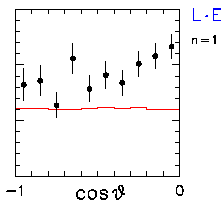
is inconsistent with the UPmu data (note that Fogli et al use a sign convention for the energy depenedence power law that is the opposite of that used by Adunas et al, so that n = 1 on the Fogli et al figure corresponds to n = -1 in the Adunas et al paper).
Fogli et al say that the MSW neutrino oscillation mechanism (red line)
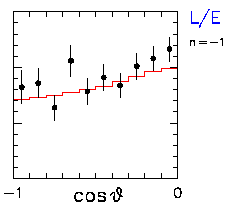
is consistent with the UPmu data (note that Fogli et al use a sign convention for the energy depenedence power law that is the opposite of that used by Adunas et al, so that n = -1 on the Fogli et al figure corresponds to n = 1 in the Adunas et al paper).
Fogli et al also dislikes the fit of the red line for n = 0 and qVEP
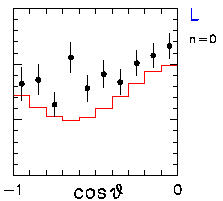
to the UPmu data, but in this case I do not agree with Fogli et al. Their MSW straight line does not follow the general curve of the UPmu data as well as the qVEP curve. Although the qVEP curve is somewhat below the UPmu data, while the MSW line is less below it, I think that the better shape-fit of the qVEP curve is important. In other words, I think that the fancy statistical best fit techniques used by Fogli et al are, in this case, misleading. Perhaps more data and/or better theoretical understanding of the qVEP model might inidicate that qVEP is indeed consistent with the SuperKamiokande UPmu data.
As if the situation were not complicated enough, there is also a superstring-motivated VEP model, ssVEP, described by Halprin and Leung, in hep-ph/9707407, where they say: "... neutrino oscillations that results from a model of equivalence principle violation suggested recently by Damour and Polyakov as a plausible consequence of string theory ... will take place through interaction with a long range scalar field of gravitational origin even if the neutrinos are degenerate in mass. The energy dependence of the oscillation length is identical to that in the conventional mass mixing mechanism. ... We therefore conclude there is the distinct possibility that the solar neutrino deficit may be telling us about a nonuniversal scalar gravitational interaction rather than the existence of a neutrino mass difference. This oscillation mechanism is phenomenologically distinguished from the conventional mass mixing mechanism by providing a rationale for the possibility that effective neutrino mass differences pertinent to solar neutrinos are small while true neutrino masses are orders of magnitude larger - with degeneracy protected by a family symmetry. ...".
As Fogli et al, in hep-ph/9904248, say: "... An alternative, string-inspired VEP mechanism, leading to an energy exponent n = -1 rather than n = 1, has been recently considered in [ Halprin and Leung, in hep-ph/9707407 ]. Its phenomenology would be indistinguishable from the standard case, as far as nu_mu -> nu_tau oscillations are involved. ...". (note that Fogli et al use a sign convention for the energy depenedence power law that is the opposite of that used by Adunas et al, so that n = -1 as used by Fogli et al corresponds to the MSW mechanism).
Since, as Fogli et al say, the SuperKamiokande data cannot distinguish between MSW and ssVEP, some other experiments will be needed to try to do so. Halprin and Leung suggest experiments to try to make direct measurements of neutrino masses and to see if there exists neutrinoless double beta decay.
My skepticism about the conclusion of Fogli et al, in hep-ph/9904248, that the upward through-going muons UPmu at SuperKamiokande exclude any energy power-law other than that of the MSW mechanism (and particularly their exclusion of VEP and qVEP), is based in part on the paper hep-ex/9806038 entitled Measurement of the flux and zenith-angle distribution of upward through-going muons in Kamiokande II+III, which paper contains the figure
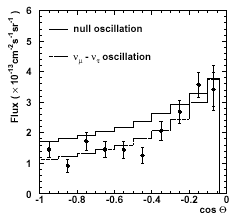
in which the upper (solid) line corresponds to expectation of null Neutrino Oscillation, while the lower (dashed) line corresponds to expectation of nu_mu <-> nu_tau Neutrino Oscillation. To my (statistically unsophisticated) eye, the two lines don't look that much different.
Further, I am not even sure that we now have a full understanding of muon physics in the relevant energy range of about 10 - 10^3 GeV. For example, consider the paper hep-ph/0106199, Attempts at Explaining the NuTeV Observation of Di-Muon Events, by Dedes, Dreiner, and Richardson, in which they say: "... The NuTeV Collaboration has observed an excess in their di-muon channel ... The NuTeV Collaboration has searched for long-lived neutral particles ... with mass ...[ at least ]... 2.2 GeV and small interaction rates with ordinary matter. They look for the decay of the neutral particles in a detector which is 1.4 km downstream from the production point. They observe 3 mu-mu events where they only expect to see a background of 0.069 +/- 0.010 events. The probability that this is a fluctuation of this specific channel is about 8 x 10^(-5), which corresponds to about 4.6 sigma The probability for a fluctuation of this magnitude into any of the di-lepton channels is about 3 sigma ...".
Experimental searches for 3-flavor Neutrino Oscillations have been conducted by the KARMEN experiment at the neutron spallation facility ISIS of the Rutherford Appleton Laboratory. 800 MeV protons hit a beam-stop and produce neutrons and pions. Negative pions are absorbed in the heavy target nuclei, whereas positive pions decay to produce muons plus mu-neutrinos, and the muons decay to produce positrons plus mu-antineutrinos plus e-neutrinos. January 1998 KARMEN results show no evidence of oscillation.
According to Gary Feldman ( slide 10 of lecture slides for the August 2000 SLAC Summer Institute ) the LSND experiment shows positive results for "...
LSND and MiniBOONE are discussed in the paper AN EXPERIMENTALIST'S VIEW OF NEUTRINO OSCILLATIONS by Antonella de Santo, hep-ex/0106089, which paper says, in part:
"... The KARMEN detector ...[is]... located 17:5 m downstream the neutrino source (about half the LSND baseline) ... the KARMEN2 result is compatible with the no-oscillation hypothesis ... the skeptical reader may find the LSND and KARMEN2 results quite contradictory. However it has to be stressed that the two experiments have sensitivities which peak at slightly different values of delta_m^2. Moreover, before any definitive conclusion can be drawn from the various results, a combined analysis of all experimental data should be performed. This has been tried for LSND and KARMEN, but only on subset of the collected data. In conclusion it is fair to say that no definitive answer has yet been given to the LSND puzzle and that more experimental data is needed. ... The MiniBOONE experiment, which is now being built at Fermilab, will address the LSND effect by searching for nu_mu -> nu_e oscillations in the same region of parameter space. ... If oscillations occur with parameters compatible with LSND solutions, after one year of running MiniBOONE should observe an excess of about 1500 nu_e events above background expectations, with a significance of about 8 to 10 sigma. On the other hand, in case of null result, after two years of running MiniBOONE should be able to completely exclude the entire LSND allowed region at 90% C.L. ... While both the solar and the atmospheric neutrino deficit have been confirmed by more than one experiment, using different experimental techniques, no other experiment has confirmed LSND observations. For this reason, given also the enormous impact that accepting the LSND result would have on our understanding of sub-nuclear phenomena, with the introduction of a light sterile neutrino, there is a tendency in the scientific community to adopt a "conservative" attitude and to exclude LSND from most phenomenogical models and fits to neutrino oscillation parameters, until more solid experimental data become available. ...".
According to an article by Phillip F. Schewe and Ben Stein in Physics New Update for 5 June 1998, the Bulletin of Physics News of The American Institute of Physics:
"NEUTRINO OSCILLATION HAS BEEN DEMONSTRATED at the Super-Kamiokande lab in Japan to a higher degree of certainty than in previous experiments. Neutrinos, weakly interacting elementary particles only detected for the first time in 1956, are thought by some theorists to reside in a kind of schizoid existence; that is, a neutrino would regularly transform (or oscillate) among several alternative neutrino states, each having a slightly different mass. Such a theory would help to explain the apparent shortfall of neutrinos coming from the Sun. The oscillation proposition has been tested using four neutrino sources: the Sun, Earth's atmosphere, reactors, and particle accelerators. Some tests find tentative but ambiguous evidence for oscillation. Today, at the Neutrino '98 conference in Takayama, Japan, the Super-Kamiokande collaboration (comprising 100 scientists from 23 institutions in Japan and the US) is announcing the most exacting evidence yet for neutrino oscillation. They study neutrinos made when cosmic rays from outer space strike the upper atmosphere. Some neutrinos, those made overhead above Japan, travel about 20 km or so before entering the underground detector. Other neutrinos, those made in the atmosphere on the far side of the globe, have a travel path of 12,700 km into the detector. In either case, they create, among other things, a high energy electron or muon, which in turn emits a telltale cone of light (Cerenkov radiation) observed by an array of thousands of photodetectors mounted in a tank filled with pure water. Sorting events by electron neutrino or muon neutrino, by high energy or lower energy, and by zenith angle (overhead approach or through the Earth), statistical evidence for oscillation becomes evident. A 1-GeV muon neutrino seems to oscillate every few hundred miles. Four years ago, the same group, using a smaller detector, reported preliminary evidence on the basis of 200 events (Physics Today, Oct 1994). The new report is based on several thousands of events, and provides an approximate mass difference (the test cannot render any neutrino species' mass directly) of about 0.07 eV. Because they are so numerous in the universe, neutrinos, with even a small mass, might play an important role in the formation of galaxies. (See http://www.phys.hawaii.edu:80/~jgl/nuosc_story.html, and Physics News, Neutrino Oscillation)"
With respect to the Super-Kamiokande demonstration of neutrino oscillation, the New York Times gave it major coverage in a Friday, 5 June 1998, article by Malcolm W. Browne entitled
The article stated "... The Super-Kamiokande experiments suggest that the difference between the masses of muon nutrinos and other types of neutrinos is only about 0.07 electron volts (a measure of particle mass). This does not yield a value of the masses themselves, only of the difference between those of muon neutrinos and other types. Although the mass of the neutrino of any flavor must be small, Totsuka [Dr. Yoji Totsuka, leader of the coalition and director of the Kamioka Neutrino Observatory] said, it may be several electron-volts, and if so, the overall gravitational effect on the universe would perhaps be significant. ..."
It is interesting to note that
Why was the headline and coverage so sensationalistic about neutrino mass? The next day, Saturday, 6 June 1998, the New York Times had another major article by Malcolm W. Browne with this headline:
According to David Kestenbaum's article in Science (281 11 Sep 1998 pp. 1594 - 1595), "... Super-Kamiokande's measurement pins down ... the difference in mass between [electron-type e-neutrinos and muon-type mu-neutrinos] and so indicates only that one of them must have a mass of at least 0.07 electron volts ... earlier experiments had set an upper limit, showing that the electron neutrino, for instance, must have a mass less than 1/30,000 of the electron's. ...". Since the electron mass is about 0.511 MeV = 511 keV = 511,000 eV, the upper limit of the e-neutrino mass is 511,000 / 30,000 = 17 eV.
The Super-Kamiokande results are consistent with the e-neutrino being massless and with the mu-neutrino having a mass of 0.07 eV, and also consistent with the VEP neutrino oscillation model in which neutrinos can oscillate and still remain massless.
In hep-ex/0107009, Final Results from the Palo Verde Neutrino Oscillation Experiment, Boehm et. al. say: "... In the experiment, the nubar_e interaction rate has been measured at a distance of 750 and 890 m from the reactors of the Palo Verde Nuclear Generating Station ... There is no evidence for neutrino oscillation and the mode nubar_e -> nubar_x was excluded at 90% CL for delta_m^2 > 1.1 x 10^(-3) eV^2at full mixing, and sin^2( 2 theta ) > 0.17 at large delta_m^2 ... Our measurements, along with those reported by Chooz and Super-Kamiokande, excludes two family nu_mu -> nu_e mixing as being responsible for the atmospheric neutrino anomaly reported by Kamiokande ... recent data from Super-Kamiokande favor the nu_mu -> nu_tau oscillation channel over nu_mu -> nu_e ...".
In hep-ex/0106102, the NOMAD Collaboration says: "... The NOMAD experiment was designed in 1991 to search for nu_tau appearance from neutrino oscillations in the CERN wide-band neutrino beam produced by the 450 GeV proton synchrotron. ... the experiment is sensitive to differences of mass squares delta_m^2 > 1 eV^2 ... The experiment was motivated by theoretical arguments suggesting that ... one expects a nu_mu mass of about 3 x 10^(-3) eV and a nu_tau mass of about 1 eV, or higher. Furthermore, in analogy with quark mixing, neutrino mixing angles were expected to be small. ... The analysis of the full NOMAD data sample gives no evidence for nu_tau appearance. ...".
......